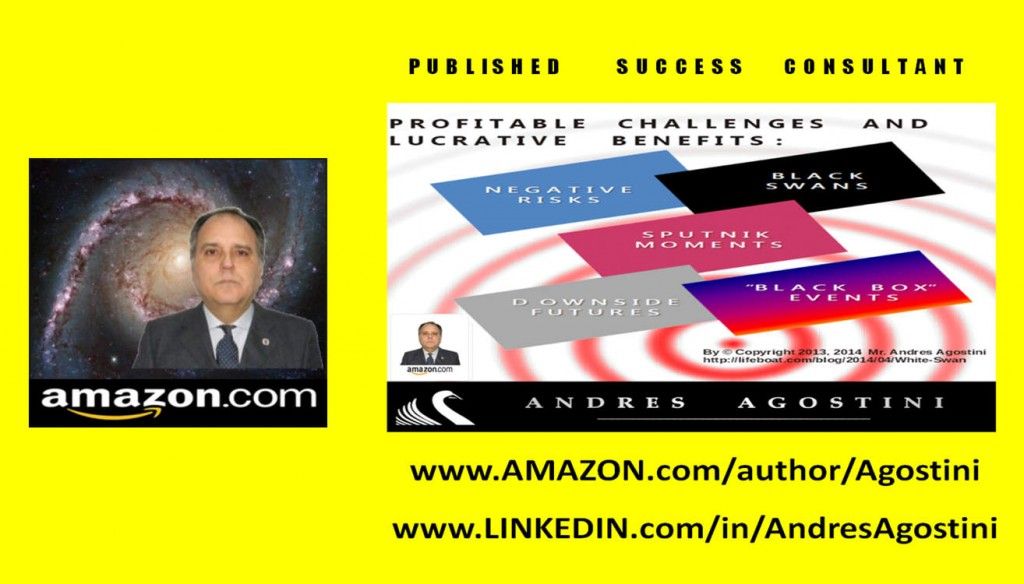Litmus-Testing Your Corporate Into For-Cash Strategy By Mr. Andres Agostini at www.linkedin.com/in/AndresAgostini
HOW TO SUCCEED IN BUSINESS ACCORDING TO THESE COMPANIES:
Berkshire Hathaway Corporation, Mitsubishi Motors, Honda, Daimler-Chrysler’s Mercedes-Benz, Toyota, Royal Dutch Shell Oil Company, Google, Xerox, Exxon-Mobil, Boeing, Amazon, Procter & Gamble, NASA and DARPA, Lockheed Martin, RAND Corporation and HUDSON Institute, Northrop Grumman Corporation, GEICO, etc.
FIRST. You fully study the corporation’s story and current culture and lexicon. You always study about their own problem-solving methodologies, proprietary or otherwise.
SECOND. You fully study the corporation’s financial and legal and compliance and tax standing.
THIRD. If the corporation is publicly traded, you strongly look into this.
FOURTH. You fully study the corporation’s industry and all of its competitors.
FIFTH. If the industry to which belongs the designated corporation is facing an extraordinary unforeseen wicked challenge, make a long executive presentation for the middle-management executives and the supervisory-level staff, fully acknowledging the details of said challenge and suggesting, as per authoritative authors in the subject matter, a well-organized myriad of viable fundamental solutions.
At all times, you are to make this executive presentation like a presentation to a sacred university professor and classroom, hence an institutional one only, and not a marketing one at all, as you objective is to break the ice and establish a Golden Bridge of Communication and Mutual Trust with your targeted corporate client, ONLY through meaningfulness, utility, relevance, and purposefulness.
In no slide you would mention your name, but in your solemn business cards.
Throughout this executive presentation, you will NEVER be addressing any theme natural to your Core Business’ Products and/or Services, but in your solemn business cards.
AN EXTRAORDINARY UNFORESEEN WICKED CHALLENGE, SOLVED, AND BANKED ON.
I will give you a real-life example of an extraordinary unforeseen wicked challenge. I had a new company, acting as a Health Maintenance Organization (HMO).
I was looking for institutional clients, both from the private sector and public sector. Every time I had a conversation with a prospective client, he would ask about my prior clients and ask,
“…Andres, are you going to run an experiment with my company and its employees without firm grounds …”
Then, I paid huge attention to Mr. Jim Rhon, and his wise sentence, “…you become [professionally and business] attractive [to the many clients in the marketplace], I then found a turnaround, perhaps a breakthrough.
As an HMO I was competing with Insurance Companies that were, at the time, presenting universal insolvency in paying healthcare claims to those insurance employees covered by and through the employer’s payroll.
Across many industries, the most-important employers’ employees were getting unnecessarily ill and even dying as the insurance companies were not paying for their “covered” medical expenses.
Accordingly, I decided to make myself the ultimate master in Public and Private Insurance Systems and Beyond and in any organizational device, paying (indemnity payments) for healthcare claims.
AND TO ILLUSTRATE THE PRACTICAL NOTION OF THE “…ULTIMATE MATTER…,” NAPOLEO BONAPARTED OBSERVED:
Napoleon Bonaparte asserted, “…I have only one counsel for you ― be master [.…] No longer it is question simply of education, NOW IT BECOMES A MATTER OF ACQUIRING [HARD] SCIENCE …” Brackets are of the author.
END OF NAPOLEON’S THOUGHT.
I took several airplanes and went up and researched everything by the World Health Organization, the private and public sectors of the U.S., Canada, U.K., and some Scandinavian countries.
As a little part of that, I litmus-test every upside and downside by every Social Security program and Healthcare Safety Net System.
As I saw and understood everything under the Sky, I made myself a world-class erudite on the subject. So, I started sending FEDEX letters to the Chief Public Affairs Offices of the largest prospective clients I want for my tiny company.
These prospective largest clients have to be big in order to have a sufficient knowledge level to transcend the old-snailed insurance company notion.
I gave them a breathtaking academic business presentation, covering every Macro Aspect through every Nano Aspect, through facilitating, step-by-step plausible solutions for each one of them.
ITEM “A” (WITHIN THE “FIFTH” NUMBER).- At the end of each business presentation, they could not believe the sophistication level of my rendition.
In fact, several stated, “…Mr. Agostini, your [pro bono] presentation and academic lecture we must pay well to you…”
ITEM “B” (WITHIN THE “FIFTH” NUMBER).- Out of each ten prospective clients and because of the preceding business presentation, I got eight (8) huge clients.
ITEM “C” (WITHIN THE “FIFTH” NUMBER).- You cannot believe the level of “…courtesy extension …” they gave me once I had completed my business presentation.
Each attendee got a white envelope with CDs and organized printed materials, accounting to over 400 top-notch researched bibliographical references, those bibliographical references that at the onset underpinned my business presentation into business making.
I gave them, each, ten (2) extra packages for all of the authorities, including, in some cases, employers’ union top representatives. Ten (10) extra packages to Chief PR Officer for all of the c-level authorities.
Ergo, now, you have to pick an extremely wicked problem for your designated prospective client, it could be one outside of the client’s core business, and adapt my account above to your own reality in dealing with said perspective client.
Use these techniques and you will be impressed. Please remember to dress up extremely well and proper.
COMMENTARY TO FIFTH. Why does it have to be a long executive presentation? I will respond through Napoleon Bonaparte’s best practices, best practices to seizing success continually.
Every time a General (Manager) under his Command would give him a one-page letter (memo, slide), Napoleon would say to his General in question,
“…General (Manager), you are to wage [to launch] a grave military campaigns [a complicated business initiative] full of mechanics, dynamics and details … Subsequently, I want to KNOW everything at all in advance, every detail at all, large or tiny or fuzzy, in order for me to issue my most-detailed commanding plans for your campaign victory [that is: your triumph in the corporate theater of operations in the global marketplace]…”
To further underpin the Napoleonic motion above, William Gates III (Bill Gates), through his book Business @ the Speed of Thought: Succeeding in the Digital Economy (ISBN: 978–0446525688), makes the case not for the relevance of “…details…”, but for the «sine qua non» vitality of “…The Granularity of Details …”
Frequently, Napoleon would dishonorably discharge this General (Manager) or have his head role for incompetence, incompetence is another word for people with a Mind “Engaged” in worshiping The Least Mental Effort, thus repudiating the “extra mile” effort.
There is too much noise about employees complaining about their bosses, but not about competent bosses complaining about their mediocre employes.
Clearly, Napoleon, during his life time and early on, heavily warns against Corporate America CEOs wanting JUST a 1-page memo delivered via email.
SIXTH. Then, you call the prospective corporate client’s P.R. person Or Communications officer and tell them about what you would like to do.
You send a letter with a summary of your presentation via FEDEX. They will give you a time and board room for your presentation, to be received by the corporation’s middle-level and supervisory-level management workers.
SEVENTH. Once you drive you car to the corporation’s office, pay extreme attention to (first) the lower-level security personnel, (second) the front-desk receptionist, and, if possible, and (third) to the great janitorial staff.
Get extremely respectful with them and treat them as the Chairman and become a bit friendly as you try to get the company’s organizational ethos by and through the lower-level security personnel, the front-desk receptionist, and the great janitorial staff.
Listen and mind-record their word types and wording construes most carefully.
In my case, by observing the front-desk receptionist for ten (10) minutes, I can tell you exactly what type of corporate culture there is about I am coping with, much more importantly than those confidential underground reports by Wall Street Bankers and Traders.
EIGHT. Before starting the executive presentation, say to the audience that you would like to introduce yourself to each one of them and shake their hands, to bring about much more psychological proximity and fore-acceptance.
Then, explain the order of your executive presentation. Second, with great care, deliver the presentation without attacking people, institutions, or even ideas.
Use, with extreme care and utility, their parlance and corporate culture at all times while you get, from A to Z, very solemnly.
Once you have thoroughly and calmly finished your executive presentation, use the Lee Iaccoca’s golden rule and state,
“ …Okay, we have completed this executive presentation and through it we saw this, that, x, y, z,…” in a summarized way.
Give them now boundaryless time and psychological space to ask you zillion questions — weird, stupid, or savvy — in the Q-and-A.
Ascertain to respond fully, accurately, on the point and with NONE MANIPULATION at all.
Take each of this business presentation an occasion to give extreme accuracy and examples of what you mean through said no-manipulation and accuracy.
In fact, tell them, AT ALL TIMES, the truths and solutions, as per your deepest and most updated research, that they did not know about it. In doing this, be extremely solemn and on the point with kindness and respect.
If there is something that you do not know, tell them, research the answer fully, and get back with the answer via a FEDEX-ed hard-copy.
Once you have responded all of the questions, give them an exact copy of the Executive Presentation, with the additional attachment of the authoritative literature you used in your evidence-based research.
Do this in hard-copy only and put it a nice white envelope. You give one package to each attendee and give the P.R. Manager three or four more for the CEO and the Board Members.
NINE. If you followed through to ULTIMATE PERFECTION, points #1 through #8, step by step, you will see them ask you something along these lines,
“…Okay, Mr. _X_, we like you evidence-based research and executive presentation and wonder who in the marketplace could offer these solutions to us …”
Without being or sounding desperate, you will say quickly and softly, “… Our Company can fully take care of those for you …”
And the idea now is that you go from a Pro Bono Executive Presentation into a formal for-business conversation with your prospective corporate client.
As the formal conversation begins, as per my long experience, tell them kindly that in parallel you want to soon fulfill the corporation’s Guidelines entirely to become a Registered Contractor as per your company’s Lines of Professional Practice.
Also in parallel, ask the mid-level managers that you are formally talking to that you would like to gain more organizational familiarity by doing incommensurable listening and some small talk with lower-level employees, including the lower-level security and janitorial staff.
Put in writing, to the PR executive, a detailed overview and hand to him or her personally.
Sometimes these folks know the corporation better than the CEO. At all times and by now, be beyond ready to be called upon to meet the Chairman, CEO, or other Board Members.
THEN, FOLLOW THROUGH THESE PRACTICAL TENETS CONDUCIVE TO OUTRIGHT VICTORY:
(1.- of 18 ).- If you want to seize the undivided attention of top executives at Los Alamos National Laboratory and Procter & Gamble, talk to them through the notions of and by Process Re-engineering.
(2.- of 18 ).- If you want to seize the undivided attention of top executives at GE, talk to them through the notions of and by Six Sigma, and Peter F. Drucker’s Management by Objective (MBO). While you are with them, remember to commend on the Jack Welch’ and Jeff Immelt’s master lectures at GE’s Crotonville.
(3.- of 18 ).- If you want to seize the undivided attention of top executives at RAND Corporation and HUDSON Institute, talk to them through the notions of and by Herman Khan’s (Dr. Strangeloves’) Scenario Methodology.
(4.- of 18 ).- If you want to seize the undivided attention of top executives at Mitsubishi Motors and Honda and Daimler-Chrysler’s Mercedes-Benz and Maytag, talk to them through the notions of and by Kaizen.
(5.- of 18 ).- If you want to seize the undivided attention of top executives at NASA and DARPA and the Industrial-Military Complex, talk to them through the notions of and by Systems Approach with the Perspective of Applied Non-Theological Omniscience.
And, also, Want to get funded by DARPA? How? The pathway is extremely easy and promissory. Just give them an unimpeachable real-life demonstration of how to “violate” the Universe’s Laws of Physics correctly and frequently, for Life!
(6.- of 18 ).- If you want to seize the undivided attention of top executives at Lockheed Martin, talk to them through the notions of and by Mean, Agile, Lean, Six Sigma, and Skunk Works.
(7.- of 18 ).- If you want to seize the undivided attention of top executives at Toyota, talk to them through the notions of and by Toyota Production System (methodology). Please remember: TPS is also known as “…Thinking People System…”
(8.- of 18 ).- If you want to seize the undivided attention of top executives at Royal Dutch Shell, talk to them through the notions of and by Pierre Wack’s Scenario Methodology (http://www.economist.com/node/12000502).
(9.- of 18 ).- If you want to seize the undivided attention of top executives at Mayo Clinic, talk to them through the notions of and by Dr. Joseph Juran’s (Total Quality Assurance) Prescription (ISBN: 978–0787900960).
Also remember to conjointly speak, at all times, of efficiency, productivity, and ROI as it stems in the incessant real-time reckoning of man-hours per patient cured and healed, transforming the dying into well-being people.
To this end, you might wish to peruse this great title: The Essential Drucker: The Best of Sixty Years of Peter Drucker’s Essential Writings on Management by Peter F. Drucker (ISBN: 978–0061345012).
(10.- of 18 ).- If you want to seize the undivided attention of top executives at Google, talk to them through the notions of and by Strong Quantum Supercomputing and Human-Death Reverse-Engineering, as well as utterly Curing Human Death.
Google will attained this canonical milestone through Calico (The name Calico is shorthand for California Life Company). Calico is an independent R&D biotechnology company established in 2013 by Google Inc., whose goal is to preemptively tackle the process of aging.
More specifically, Calico’s plan is to use advanced technology to increase understanding of the biology that controls lifespan, and to use that knowledge to increase longevity and cure human death.
Google’s electric driver-less car, among other amenities, will be achieved by a moon-shooting subsidiary, meaning “…Google Extreme,…” seriously known as: Google X and his Chief Scientist Officer to “…change the World,…” Dr. Astro Teller.
(11.- of 18 ).- If you want to seize the undivided attention of top executives at Xerox, talk to them through the notions of and by PARC (Palo Alto Research Center Incorporated).
(12.- of 18 ).- If you want to seize the undivided attention of top executives at Rockefeller’s ExxonMobil, talk to them through the notions of and by Efficiency and Productivity as well as the notions of and by Return On Investment (ROI) per Petroleum Barrel produced (outputted), and Project Management.
(13.- of 18 ).- If you want to seize the undivided attention of top executives at Boeing, talk to them through the notions of and by Aerospace Engineering, Avionics, Systems Engineering, Reliability Engineering, Safety Engineering, Industrial Engineering, and Mechanical Engineering.
(14.- of 18 ).- If you want to seize the undivided attention of top executives at SETI (Search for Extra-Terrestrial Intelligence), talk to them through the notions of and by Super-intelligence entrenched, in “… plain sight…,” in the covert «…ad infinitum …» realm of Dark Energy and Dark Matter.
(15.- of 18 ).- If you want to seize the undivided attention of top executives at Loyd’s of London, GEICO, Swiss RE, Munich RE, and Allianz, talk to them through the notions of and by Minimax, Statistics, Actuarial Science, Predictive Analytics, and Systems Engineering.
(16.- of 18 ).- If you want to seize the undivided attention of top executives at Amazon, talk to them through the notions of and by Low-Cost And High-End Online Commerce, Content Creation, Hi-Tech, Cloud Computing, Quadcopters (Commercial Flying Drones), and Eternal Staggering Innovation. Don’t forget to mention the artificial sage, namely the “… Mechanical Turk …”
(17.- of 18 ).- If you want to seize the undivided attention of top executives at Northrop Grumman Corporation, talk to them through the notions of and by State of the Art: Quality, Continuous Improvement, Customer Satisfaction, Leadership (Man-Management and Statesmanship), Integrity, People, Suppliers, Sound Business Management, “…Best in Class…” Products and Services, and how to preemptively countermeasure Chinese penetrations and otherwise of both commercial and government networks in the United States.
(18.- of 18 ).- Then, you want to do business with the Oracle of Omaha’s Berkshire Hathaway Inc. Right? You want to get his undivided attention to offer him your professional services and seize him as your cash-paying institutional client.
If this is the case, you need to send a shrewd clear-eyed missive to Warren E. Buffett’s Mr. Charlie Munger, Business Magnate and Vice-Chairman of Berkshire Hathaway Corporation and Warren’s second best friend, after Bill Gates, number one.
You use the best stationary (at least 25% made of cotton) you can use and your proposal is to be sent, under the most expensive priority, via FEDEX, with a white envelope, to:
The Most Honorable Mr. Charlie Munger
Vice-Chairman
Berkshire Hathaway Corporation
3555 Farnam Street
Suite 1440
Omaha, NE 68131
(402) 393‑7255 (double check)
Through that letter, you mention seven lines of the wisdom you have gotten from Warren’ and Bill’s favorite book lists, book by book, as follows:
Business Adventures: Twelve Classic Tales from the World of Wall Street by John Brooks
ISBN: 978–1497644892
Essays In Persuasion by John Maynard Keynes
ISBN: 978–1441492265
The Theory of Investment Value by John Burr Williams
ISBN: 978–0870341267
The Intelligent Investor: The Definitive Book on Value Investing. A Book of Practical Counsel (Revised Edition… by Benjamin Graham, Jason Zweig
ISBN: 978–0060555665
The General Theory Of Employment, Interest, And Money by John Maynard Keynes
ISBN: 978–1467934923
The People v. Clarence Darrow: The Bribery Trial of America’s Greatest Lawyer by Geoffrey Cowan
ISBN: 978–0812963618
A Piece of the Action: How the Middle Class Joined the Money Class by Joe Nocera
ISBN: 978–1476744896
Money Masters of Our Time by John Train
ISBN: 978–0887309700
Paths to Wealth Through Common Stocks by Philip A. Fisher and Kenneth L. Fisher
ISBN-13: 978–0470139493
The Science of Hitting by Ted Williams, John Underwood and Robert Cup
ISBN: 978–0671621032
Only the Paranoid Survive: How to Exploit the Crisis Points That Challenge Every Company by Andrew S. Grove
ISBN: 978–0385483827
The New Quotable Einstein by Alice Calaprice, Freeman Dyson and Albert Einstein
ISBN: 978–0691120751
The Farmer from Merna: A Biography of George J. Mecherle and a History of the State Farm Insurance Companies of… by Karl Schriftgiesser
ISBN: 978–0812984347
THEN:
Remember to mention, in a thoughtful and smart way, your admiration for the United States, the Free Enterprise, Omaha, the Cheeseburger, GEICO, the Bambino, Babe Ruth, and Warren’s massive ironclad pecuniary contribution to Bill & Melinda Gates Foundation, as well as the opportunities that this non-for-profit non-governmental organization offers, with the express end to solve intractable problems in the developing world.
N.B. #1: If anything of the Institutions above has a major proprietary Methodology or Problem-Solving Methodology to fundamentally tackle with Issue A, Issue B, and Issue C, and in case that you ALSO have your own major proprietary Methodology or Problem-Solving Methodology to fundamentally tackle with Challenge Alpha, Challenge Beta, and Challenge Gamma — to the greatest competitive advantage of the Institutions above —, DO NOT EVER EVER MAKE DIRECT OR INDIRECT COMPARISSONS.
AND NEVER EVER UNDERMINE OR TALK ABOUT THEIR METHODOLOGIES OR SYSTEMS IN A DISFAVORABLE WAY.
If you have to, go all the way to acknowledge their solution tool-kits frequently and get busied doing yours without offending anyone. Be extremely carefully.
N.B. #2: I know great c-suite consulting incumbents and other professional service providers who want to get the undivided attention of 90% of the CEOs above at once.
The majority of those CEOs are august applied scientists. They are only into applied scientific management. Ergo, they really need to get ready to be multidimensional and cross-functional and multifarious.
There is NEVER EVER an Internet resource, nor an online book or article giving you this most-profound advice.
Authored By Copyright Mr. Andres Agostini
White Swan Book Author
www.linkedin.com/in/andresagostini
www.amazon.com/author/Agostini






